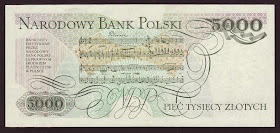Poland Banknotes 5000 Zloty banknote 1982 Frederic Chopin
National Bank of Poland - Narodowy Bank Polski
Polish People's Republic - Polska Rzeczpospolita Ludowa
Obverse: Portrait of Frederic Chopin (1810-1849) composer and pianist of the Romantic period.
Reverse: Fragment of the notes of Chopin's "Polonaise".
Watermark: White Eagle - Coat of arms of Poland.
signatures:
President of the National Bank of Poland - Stanislaw Majewski
Chief Treasurer of the National Bank of Poland - Jerzy Lasocki
Issue Date: June 1, 1982
Dimension: 138 x 63 mm
Printer: PWPW - Polska Wytwórnia Papierów Wartościowych S.A. (Polish Security Printing Works, Warsaw, Poland)
Banknote design by Andrzej Heidrich, engraved by Boguslaw Brandt.
In Circulation: from June 11, 1982 to December 31, 1996
Poland banknotes - Poland paper money
1974-1993
2000 Zloty 5000 Zloty 10000 Zloty 20000 Zloty 50000 Zloty
100000 Zloty 200000 Zloty 500000 Zloty 1000000 Zloty 2000000 Zloty
Frédéric Chopin
Frédéric François Chopin (22 February or 1 March 1810 – 17 October 1849), born Fryderyk Franciszek Chopin, was a Polish composer and virtuoso pianist of the Romantic era, who wrote primarily for the solo piano. He gained and has maintained renown worldwide as one of the leading musicians of his era, whose "poetic genius was based on a professional technique that was without equal in his generation." Chopin was born in what was then the Duchy of Warsaw, and grew up in Warsaw, which after 1815 became part of Congress Poland. A child prodigy, he completed his musical education and composed many of his works in Warsaw before leaving Poland at the age of 20, less than a month before the outbreak of the November 1830 Uprising.
At the age of 21 he settled in Paris. Thereafter, during the last 18 years of his life, he gave only some 30 public performances, preferring the more intimate atmosphere of the salon. He supported himself by selling his compositions and teaching piano, for which he was in high demand. Chopin formed a friendship with Franz Liszt and was admired by many of his musical contemporaries, including Robert Schumann. In 1835 he obtained French citizenship. After a failed engagement to a Polish girl, from 1837 to 1847 he maintained an often troubled relationship with the French writer George Sand. A brief and unhappy visit to Majorca with Sand in 1838–39 was one of his most productive periods of composition. In his last years, he was financially supported by his admirer Jane Stirling, who also arranged for him to visit Scotland in 1848. Through most of his life, Chopin suffered from poor health. He died in Paris in 1849, probably of tuberculosis.
All of Chopin's compositions include the piano. Most are for solo piano, though he also wrote two piano concertos, a few chamber pieces, and some songs to Polish lyrics. His keyboard style is highly individual and often technically demanding; his own performances were noted for their nuance and sensitivity. Chopin invented the concept of instrumental ballade. His major piano works also include sonatas, mazurkas, waltzes, nocturnes, polonaises, études, impromptus, scherzos, and preludes, some published only after his death. Many contain elements of both Polish folk music and of the classical tradition of Johann Sebastian Bach, Mozart and Schubert, the music of all of whom he admired. His innovations in style, musical form, and harmony, and his association of music with nationalism, were influential throughout and after the late Romantic period.
Both in his native Poland and beyond, Chopin's music, his status as one of music's earliest superstars, his association (if only indirect) with political insurrection, his love life and his early death have made him, in the public consciousness, a leading symbol of the Romantic era. His works remain popular, and he has been the subject of numerous films and biographies of varying degrees of historical accuracy.
The polonaise (Polish: polonez) is a dance of Polish origin, in 3/4 time. Its name is French for "Polish."
The polonaise had a rhythm quite close to that of the Swedish semiquaver or sixteenth-note polska, and the two dances have a common origin.
Polonaise is a widespread dance in carnival parties. Polonaise is always a first dance at a studniówka ("hundred-days"), the Polish equivalent of the senior prom that occurs approximately 100 days before exams.
Frédéric Chopin's polonaises are generally the best known of all polonaises in classical music.
Polonaise is a Polish dance and is one of the five historic national dances of Poland. The others are the Mazurka (Mazur), Kujawiak, Krakowiak and Oberek, last three being old folk dances. Polonaise originated as a peasant dance known under various names – chodzony ("pacer"), chmielowy ("hops"), pieszy ("walker") or wielki ("great"), recorded as early as the 15th century. In later centuries it gained popularity among the nobility and townspeople.

